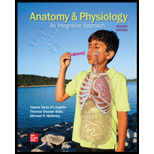
Concept explainers
Introduction:
Blood is a connective tissue which flows from the heart through arteries and veins to all body parts. Whole blood consists of two elements- formed elements and plasma. The total volume of formed elements in the blood which are erythrocyte, platelets, and leukocytes is called as hematocrit. But clinically the total percentage of erythrocytes in blood is known as hematocrit.
Answer to Problem 1DYKB
Correct answer:
The value of hematocrit varies according to sex and age of individuals. The hematocrit of very young children may vary from
Explanation of Solution
Reason for the correct statement:
Option b. is given as “a dehydrated adult male”. The percentage of hematocrit is affected by dehydration condition. If a person has a high hematocrit range it means the person is either suffering from dehydration or is involved in blood doping. As the value of hematocrit is already higher than children and females, its value will increase more in dehydration condition. Thus, the hematocrit value of a dehydrated male will be maximum. Hence; the hematocrit value would be highest in a dehydrated male.
Hence, option b. is correct.
Reasons for the incorrect statements:
Option a. is given as “a 10-year old child”. The hematocrit of very young children may vary from
Option c. is given as “a healthy, nonmenstruating female”. In adult females, the hematocrit value ranges between
Option d. is given as “a healthy, menstruating adult female”. In adult females, the hematocrit value ranges between
Hence, options a., c., and d. are incorrect.
The hematocrit range value would be highest in a ten-year-old boy than a dehydrated male and a healthy female.
Want to see more full solutions like this?
Chapter 18 Solutions
ANATOMY+PHYSIOLOGY(LL)-W/CONNECT ACCESS
- Match the structures found in the fetal circulation with what each fetal structure becomes after birth: _____ Foramen ovale a. Ligamentum venosum _____ Ductus arteriosus b. Fossa ovalis _____ Ductus venosus c. Ligamentum arteriosarrow_forwardPituitary dwarfism is a childhood onset condition that can be caused by a brain tumour or head trauma. It can result in decreased secretion of several pituitary hormones.Two expected symptoms of pituitary dwarfism are Select one: a. hypothyroidism and lack of menstruation b. hyperthyroidism and increased blood flow during menstruation c. hyperparathyroidism and increased blood flow during menstruation d. hypoparathyroidism and lack of menstruationarrow_forwardYour friend suffers from testosterone deficiency. Which of the following is a possible sign? Select one: A. Enlargement of the larynx B. Increased skin thickness C. Excessive chest and facial hair D. Clear skin which is free of pimples E. Bulky skeletal muscle development O O O O Oarrow_forward
- The patient has got diagnose acromegaly. Hyperactivity of what cells of the pituitary gland are causes this disease? a. Gonadotropes b. Thyrotropes c. Mammotropes d. Somatotropes e. Chromophobesarrow_forwardPremature babies are at high risk for: A. Hypertension B. Jaundice C. Osteoporosis D. Hyperglycemiaarrow_forwardMother A tells the nurse she uses Methamphetamine. “ This drugs may affect my baby? What will be the possible symptoms my newborn have at birth?”. Which of the following manifestation of the newborn that the nurse explains to the mother? A. “ Your baby might be sleepy most of the time” B. “Your baby might have greenish to blackish stool C. “Your baby might show jitteriness and poor feeding” D. “Your baby might be unsettle most of the time”arrow_forward
- Which of the following statements is (are) true about polycythemia?a. Polycythemia increases blood pressure.b. Polycythemia can result from cancer, hypoxemia, or dehydration.c. Polycythemia is diagnosed from a white blood cell differential test.d. Polycythemia is often a problem for smokers.e. Polycythemia can occur when the body has chronic exposure to carbon dioxidearrow_forwardWhich of the following medical assessments is abnormal and would be of concern for the physician? a. Blood pressure is above normal. b. Urinalysis results are abnormal. c. Ashley’s blood glucose levels are above normal. d. All of the medical findings are within normal ranges for a pregnant woman.arrow_forwardA complication of genital gonorrhea in both men and women isa. infertility b. pelvic inflammatory disease c. arthritis d. blindnessarrow_forward
- A 68-year-old male with a history of prostate enlargement presents with lower back pain, difficulty in urination, and elevated prostate-specific antigen (PSA) levels. What is the most likely diagnosis? A. Benign prostatic hyperplasia B. Prostate cancer C. Urinary tract infection D. Prostatitisarrow_forwardA pregnant client states that she "waddles" when she walks. The nurse's explanation is based on which of the following as the cause? * A. The large size of the newborn. O B. Pressure on the pelvic muscles. C. Relaxation of the pelvic joints. D. Excessive weight gain.arrow_forwardWhich of the following is reported using a neoplasm code? a. mild dysplasia of the cervix b. Cervical intraepithelial neoplasia I c. moderate dysplasia of the cervix d. Cervical intraepithelial neoplasia IIIarrow_forward
 Medical Terminology for Health Professions, Spira...Health & NutritionISBN:9781305634350Author:Ann Ehrlich, Carol L. Schroeder, Laura Ehrlich, Katrina A. SchroederPublisher:Cengage Learning
Medical Terminology for Health Professions, Spira...Health & NutritionISBN:9781305634350Author:Ann Ehrlich, Carol L. Schroeder, Laura Ehrlich, Katrina A. SchroederPublisher:Cengage Learning- Essentials of Pharmacology for Health ProfessionsNursingISBN:9781305441620Author:WOODROWPublisher:Cengage



